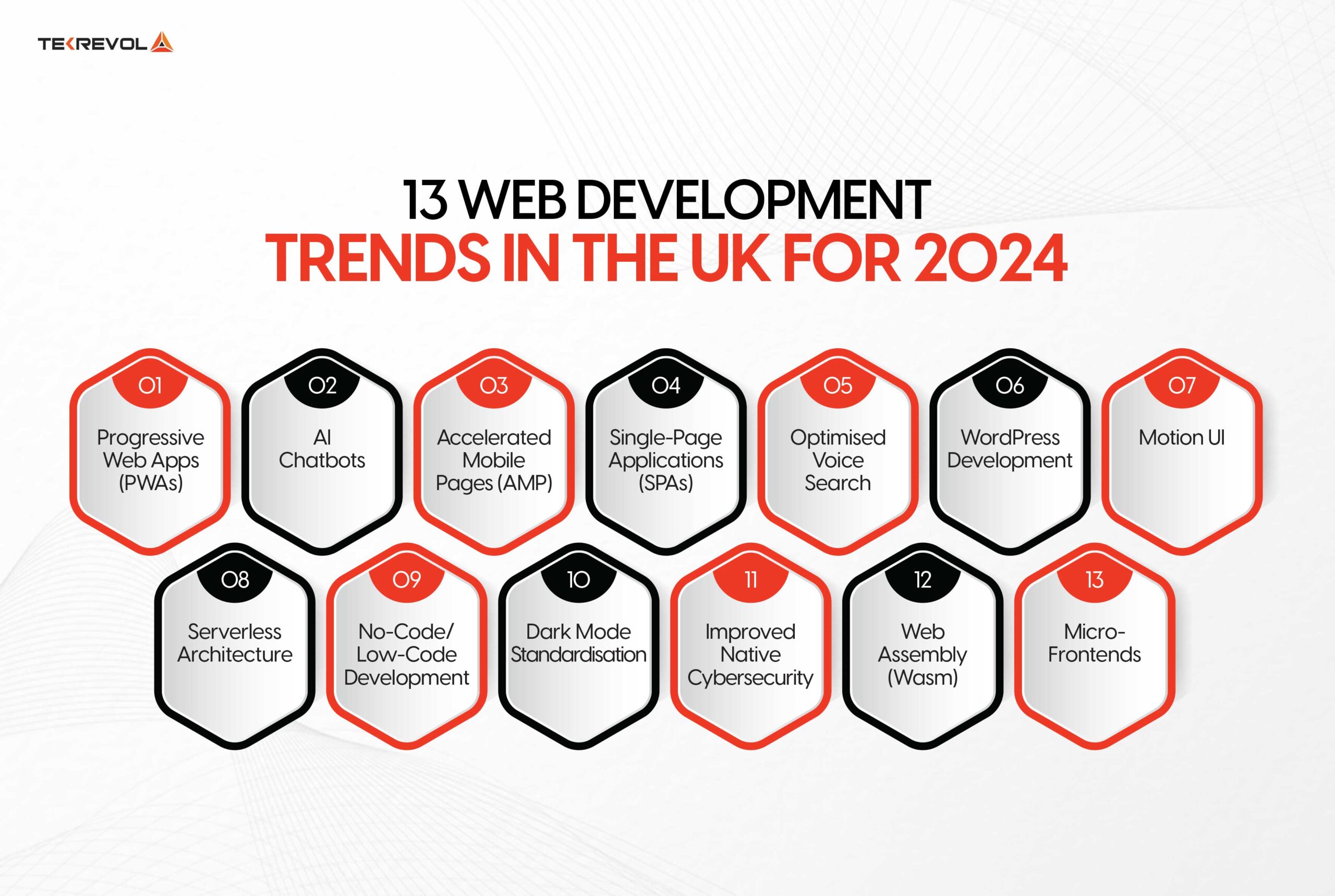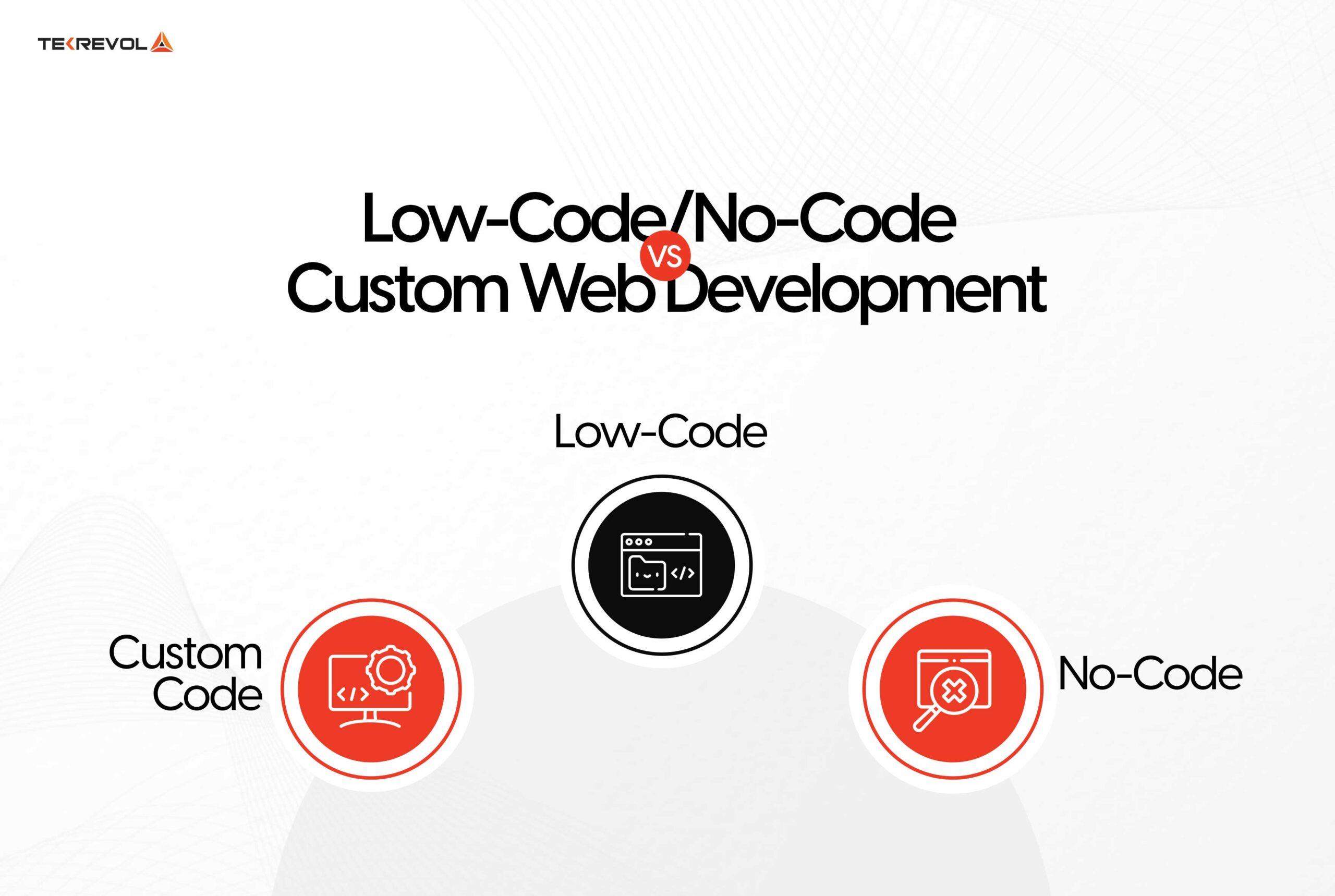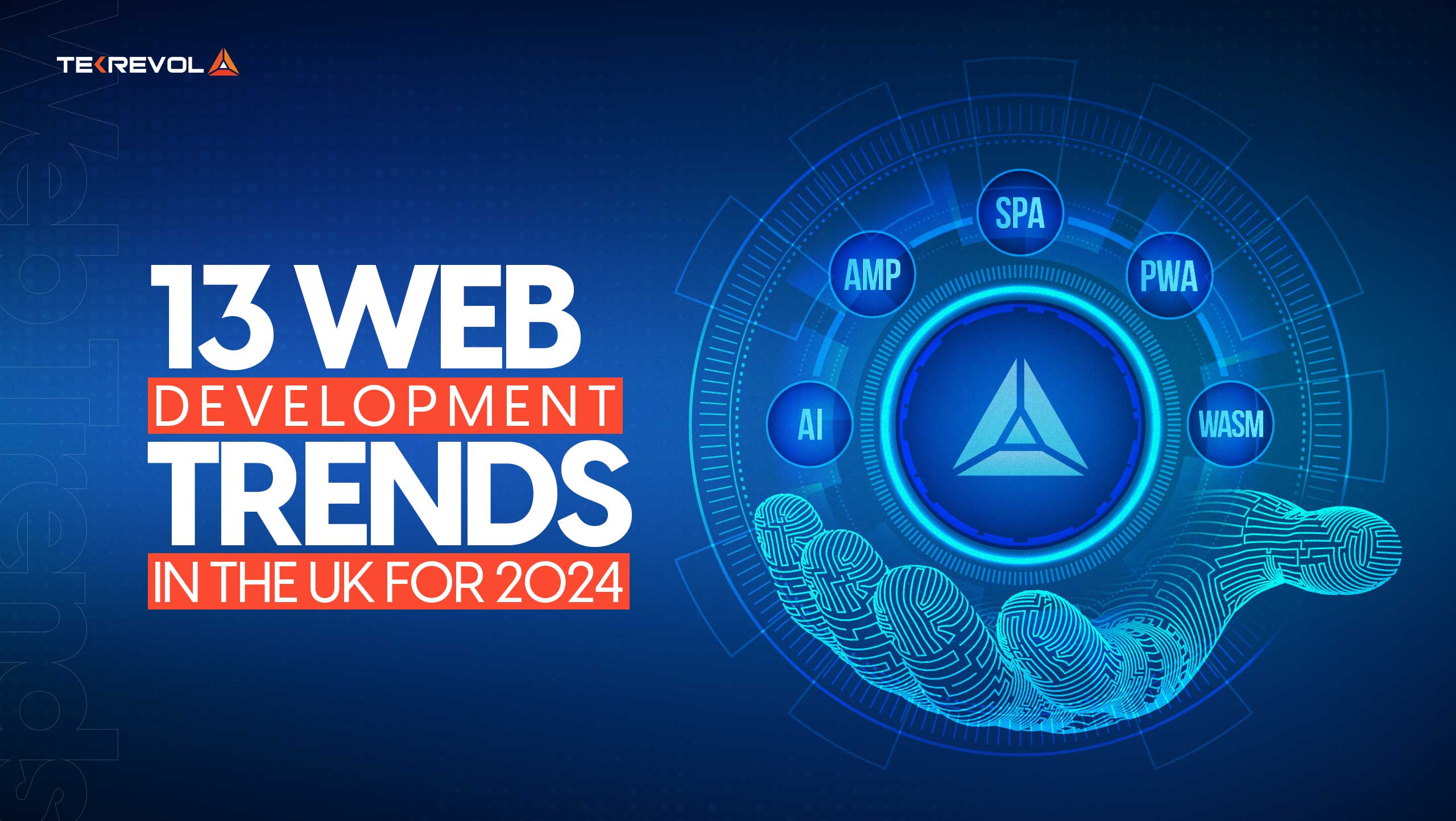With the rapid increase in digital interactions, there is intensification in the competition among businesses to thrive. Not only thrive but also meet user expectations and win over growing compatibility challenges.
Almost 60% of users abandon web purchases due to poor UX. Cluttered web pages with too many elements can cause conversion rates to drop by up to 95%.
To be on top, businesses must adapt to modern web development trends in the UK. Here are 13 trending approaches and technologies in the UK web development landscape that help you boost user experience, align with cross-platform requirements, and meet the evolving search engine criteria.
Web Development Trends In The UK For 2025
Let’s unfold each trending approach to better understand their technicalities, use cases, and demand in the new-age digital environment.

-
Progressive Web Apps (PWAs)
PWAs redefine web development with optimal user experiences across devices. These apps have the functionalities of both web and native applications. PWAs are developed using HTML, CSS, JavaScript, and contemporary frameworks such as React or Angular and can support swift loading, offline use, and push notifications, which makes them reliable in weak network connections.
PWAs are gradually implemented by modern businesses because of the benefits such as cost reduction and low maintenance. Some giant enterprises such as Starbucks, Uber, and Twitter have implemented this technology to increase customer engagement and lower bounce rates.
One of the greatest advantages of PWAs is the offline-first approach, which helps to retain customers and make them happy. The primary advantage of PWAs is that they are installed on the home screen without downloads from app stores, and this means a frictionless user experience.
As mobile devices contribute to more than 64% of the world’s internet traffic, the drive towards mobile-first design will ensure that PWAs are a necessity for any online approach.
-
AI Chatbots
Customer support is predicted to experience the highest level of AI chatbot adoption in 2025. With the help of such tools as machine learning, natural language processing, and AI algorithms, these chatbots have become smarter, offering customers individualised and immediate assistance. They are not only faster but also more efficient for handling several concurrent customer requests.
From buying online to speaking to a tele-consultant during a medical emergency, AI bots are now being used to complete transactions. Applications such as GitHub Copilot automate certain coding activities, thereby reducing time to delivery.
Therefore, it can be foreseen that by the year 2025 AI chatbots will become more advanced in terms of sophistication to facilitate business organisations to foresee the customers’ behaviour, solve problems faster and further improve the users’ experience. It will be crucial to embed chatbots into web platforms to enhance user experience, minimise expenses, and increase sales.
-
Accelerated Mobile Pages (AMP)
Accelerated Mobile Pages (AMP) are designed to enhance mobile site performance and user experience load incredibly fast. AMP of Google helps reduce the page weight and load the page even on slow connections. Even though AMP was introduced in 2015, it remains relevant in 2025 as mobile-first indexing remains the primary focus of SEO.
AMP improves the user experience, lowers bounce rates, and boosts sales. While the adoption rate of mobile technologies is slightly lower than in 2020, more than half of the websites that implemented AMP still benefit from it in terms of loading speed.
AMPs are useful for e-commerce sites, sites with lots of content, and news sites as user engagement is directly related to performance. AMP can be a valuable tool for businesses interested in the mobile experience, as it can improve page experience metrics such as Core Web Vitals.
- Build Your MVP Fast
- Launch a scalable MVP tailored for rapid market entry and validation.
-
Single-Page Applications (SPAs)
Single Page Applications (SPAs) help manage web navigation by loading only part of the content instead of a page. Developed using JavaScript frameworks such as Angular and React, SPAs enhance user experiences through reduced server interactions. Some of the popular companies that have implemented SPAs to improve their site efficiency include Facebook, Google, and Twitter.

By the year 2025, SPAs will remain relevant because of the flexibility of updating content in real-time and better user engagement. SEO restrictions on forums—fewer unique URLs—do not significantly affect the forums since they are optimised for social networks and other closed platforms where the SEO rank is not the primary concern.
Hence, SPAs are most suitable for SaaS applications, dashboards, and information-rich websites; they enable faster and smoother interactions for the users without compromising performance.
-
Optimised Voice Search
The use of voice assistants such as Siri, Alexa, and Google Assistant will be a dominant trend in 2025 due to voice search optimisation. AI and NLP developments are enabling voice searches to become more natural and accurate.
Companies need to ensure that the keywords they target are tailored for conversational searches as voice search is designed to return results that are as specific and local as possible.
One of the ways that SEO is affected by the rising popularity of voice search is the optimization of keywords to enable the search engines to identify voice-based queries. Even more, it is expected that, by 2025, more companies will incorporate voice-first approaches to make their website available on smart speakers and mobile voice assistants.
Through understanding the user intention and developing content that answers the questions, businesses can benefit from this trend and enhance visibility.
-
WordPress Development
WordPress remains the market leader in content management systems, providing the infrastructure for 43% of the world’s websites. In 2025, headless WordPress comes to the fore, where the front end and back end are no longer intertwined, providing much freedom to the developer.
This architecture enables the integration of modern front-end frameworks such as React and still uses the powerful content management system of WordPress.
WordPress has become popular due to its rich community of add-ons, such as plugins, themes, and third-party services, which are suitable for businesses of any size.
As the trends in web development progress to advanced and modular architectures, WordPress is likely to incorporate new features such as enhanced block editors, as well as security enhancements. Therefore, for any business that seeks to boost its online presence, WordPress remains a strong and flexible platform.
- Modernise Your Website
- Upgrade with modern frameworks and improved performance for a competitive edge.
-
Motion UI
Motion UI is a growing web development trend in the UK, offering dynamic and interactive user experiences. Motion UI uses CSS transitions and animations to create engaging, responsive interfaces. Popular for its compatibility with various front-end technologies, Motion UI enhances user interactions by providing intuitive feedback, improving navigation, and making websites visually appealing.
Motion UI is especially useful in e-commerce and content-heavy platforms where user engagement is critical. Frameworks like Material Design and JavaScript libraries such as Anime.js enable developers to create fluid, animated components that enrich the user experience. In 2025, the demand for immersive digital experiences will push Motion UI further into the mainstream, as users increasingly expect interactive and dynamic content.
-
Serverless Architecture
Serverless architecture allows developers to build and run applications without managing infrastructure. Cloud providers like AWS, Google Cloud, and Microsoft Azure offer serverless computing services, reducing costs and simplifying backend management. Serverless technology supports automatic scaling, enabling developers to deploy code without worrying about provisioning or server maintenance.
In 2025, the rise of serverless technology will drive innovation in web development. Startups and enterprises alike will adopt serverless architectures for building microservices, APIs, and IoT applications. The serverless model improves application performance, reduces downtime, and cuts operational costs, making it an attractive option for businesses seeking scalability and efficiency.
-
No-Code/Low-Code Development
Low-code and no-code solutions are the new future of web development, as they enable non-developers to build websites and applications. These platforms offer user-friendly interfaces that allow the user to work on the webpage design by placing the necessary elements on the page without the need to write code. Businesses will continue to invest in no-code and low-code solutions in 2025 for prototyping and MVP creation.

WordPress, Wix, and HubSpot’s CMS Hub are some of the most widely-used no-code platforms that provide users with the ability to create responsive and scalable websites without programming skills.
This web development trend in the UK makes it easier for businesses to build apps without involving web developers. No-code/low-code platforms will become indispensable tools for swift and cost-efficient digital transformation since they level the entry barrier.
- Dominate Mobile-First Markets
- Design responsive, mobile-first websites that outperform on any device.
-
Dark Mode Standardisation
Dark mode is now a standard feature in web design, with platforms such as Facebook and Twitter integrating it into their systems. Research suggests that 80% of users switch to dark mode to mitigate eye strain and battery on OLED screens. Therefore, it has become common to see organisations adopting dark modes for their websites and applications.
Dark mode will become even more popular in 2025 as developers pay more attention to user experience and customisation. The sites that are designed with the dark mode provide better readability compared to the sites with normal mode, especially at night.
Moreover, Web Content Accessibility Guidelines (WCAG) check that dark mode designs conform to accessibility requirements, which makes it a crucial pattern in inclusive web design.
-
Improved Native Cybersecurity
In 2025, native cybersecurity features become the focus of web development due to the growth of cyber threats. Current measures such as MFA, SSL encryption, and better firewalls are already in place to secure the data of the users. As a result of the recent massive breaches, companies have increased spending on proper security to protect personal information.
Security in web development has been taken as a key priority in web development, with developers implementing measures such as patching, vulnerability assessment, and security surveillance. Organisations should incorporate these tools into their development life cycle to avoid leakage of information, safeguard their image and gain the trust of users.
These demands will become particularly relevant in 2025 as cybersecurity will continue to evolve and develop even stronger security standards for any web development project.
-
WebAssembly (Wasm)
WebAssembly (Wasm) is a binary format that is designed to achieve near-native performance of web applications. In 2025, WebAssembly will be increasingly adopted to optimise web applications for performance, especially for computationally demanding use cases such as gaming, image processing, and real-time data analytics.
WebAssembly enables the execution of code written in languages such as C, C++, Rust, etc., in the browser environment with nearly native performance. This performance improvement makes WebAssembly a great option for apps that involve a lot of computation or real-world interaction.
Shortly, we will witness further use of WebAssembly as a tool for boosting the loading speed and enhancing the experience, primarily for websites belonging to the gaming, financial, and AI industries.
-
Micro-Frontends
Micro-frontends are becoming popular as a method of scaling web development by dividing the front end into more manageable parts. This way, each team can create and run micro-frontends on their own, which lets businesses scale web applications better.
This architecture is more flexible and can be updated much quicker because changes made to one micro-frontend do not affect the rest of the application. Micro-frontends are useful in large enterprises as they help minimise the codebase and allow for integration frequently.
Well-known organisations such as Spotify and IKEA have adopted this approach for their web applications. The micro-frontends architecture in 2025 will lead to enhanced scalability, speed of development, and better collaboration among teams in different businesses.
Build High-Performing Websites In The UK With TekRevol
TekRevol is your go-to web development company in the UK for creating excellent websites. Our core values are speed, scalability, and usability of the digital solutions tailored for your business. Our web development process focuses on integrated and advanced web solutions such as responsiveness, performance, and UX to increase conversion rates and enhance web performance.
That is why at TekRevol, every developed and designed website is optimised to perform well in the UK market. Our services focus on efficient loading time, security, and mobile-first approach so that your website meets your performance and business objectives. If you require a bespoke website or if you require the enhancement of your current platform, TekRevol offers the level of technicality and competence you are seeking for. Hire a web development company in the UK that can actually deliver tangible results and sustainable methods.
- Revamp Your Website Fast
- Upgrade your site with modern technologies to boost speed, security, and UX.
Why Businesses Must Focus On Web Development Trends In The UK For 2025?
While user demands continue to rise and search engines focus on providing faster and easier access to information, keeping up with the modern web development trends is a crucial aspect for companies in the UK in 2025. This way, concentrating on the latest web technologies will not only make the site more user-friendly but also higher in ranking, making it more easily searchable.
Thus, the adoption of such trends as load time optimisation and the mobile-first approach can help address the increasing user expectations and improve organisations’ online performance. These trends guarantee that websites are not only fully functional but are also optimally responsive to the devices used.
Organisations operating in the UK that implement the latest web development approaches for their businesses are in a position to succeed by generating enhanced customer engagement and business success through faster, more responsive websites that are relevant to today’s informed users.
- Scale Your Web Platform
- Develop custom web solutions built to handle high traffic and future growth.

 3690 Views
3690 Views September 18, 2024
September 18, 2024






